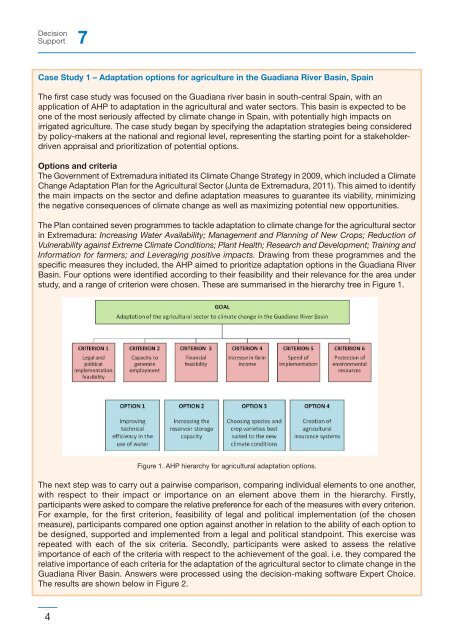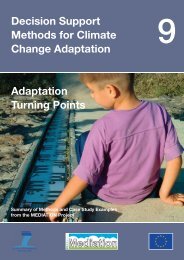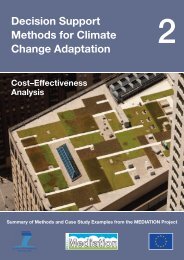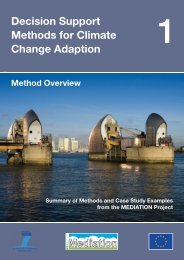Download all Technical Policy Briefing Notes in a single ... - Mediation
Download all Technical Policy Briefing Notes in a single ... - Mediation
Download all Technical Policy Briefing Notes in a single ... - Mediation
- No tags were found...
Create successful ePaper yourself
Turn your PDF publications into a flip-book with our unique Google optimized e-Paper software.
DecisionSupport 7Case Study 1 – Adaptation options for agriculture <strong>in</strong> the Guadiana River Bas<strong>in</strong>, Spa<strong>in</strong>The first case study was focused on the Guadiana river bas<strong>in</strong> <strong>in</strong> south-central Spa<strong>in</strong>, with anapplication of AHP to adaptation <strong>in</strong> the agricultural and water sectors. This bas<strong>in</strong> is expected to beone of the most seriously affected by climate change <strong>in</strong> Spa<strong>in</strong>, with potenti<strong>all</strong>y high impacts onirrigated agriculture. The case study began by specify<strong>in</strong>g the adaptation strategies be<strong>in</strong>g consideredby policy-makers at the national and regional level, represent<strong>in</strong>g the start<strong>in</strong>g po<strong>in</strong>t for a stakeholderdrivenappraisal and prioritization of potential options.Options and criteriaThe Government of Extremadura <strong>in</strong>itiated its Climate Change Strategy <strong>in</strong> 2009, which <strong>in</strong>cluded a ClimateChange Adaptation Plan for the Agricultural Sector (Junta de Extremadura, 2011). This aimed to identifythe ma<strong>in</strong> impacts on the sector and def<strong>in</strong>e adaptation measures to guarantee its viability, m<strong>in</strong>imiz<strong>in</strong>gthe negative consequences of climate change as well as maximiz<strong>in</strong>g potential new opportunities.The Plan conta<strong>in</strong>ed seven programmes to tackle adaptation to climate change for the agricultural sector<strong>in</strong> Extremadura: Increas<strong>in</strong>g Water Availability; Management and Plann<strong>in</strong>g of New Crops; Reduction ofVulnerability aga<strong>in</strong>st Extreme Climate Conditions; Plant Health; Research and Development; Tra<strong>in</strong><strong>in</strong>g andInformation for farmers; and Leverag<strong>in</strong>g positive impacts. Draw<strong>in</strong>g from these programmes and thespecific measures they <strong>in</strong>cluded, the AHP aimed to prioritize adaptation options <strong>in</strong> the Guadiana RiverBas<strong>in</strong>. Four options were identified accord<strong>in</strong>g to their feasibility and their relevance for the area understudy, and a range of criterion were chosen. These are summarised <strong>in</strong> the hierarchy tree <strong>in</strong> Figure 1.Figure 1. AHP hierarchy for agricultural adaptation options.The next step was to carry out a pairwise comparison, compar<strong>in</strong>g <strong>in</strong>dividual elements to one another,with respect to their impact or importance on an element above them <strong>in</strong> the hierarchy. Firstly,participants were asked to compare the relative preference for each of the measures with every criterion.For example, for the first criterion, feasibility of legal and political implementation (of the chosenmeasure), participants compared one option aga<strong>in</strong>st another <strong>in</strong> relation to the ability of each option tobe designed, supported and implemented from a legal and political standpo<strong>in</strong>t. This exercise wasrepeated with each of the six criteria. Secondly, participants were asked to assess the relativeimportance of each of the criteria with respect to the achievement of the goal. i.e. they compared therelative importance of each criteria for the adaptation of the agricultural sector to climate change <strong>in</strong> theGuadiana River Bas<strong>in</strong>. Answers were processed us<strong>in</strong>g the decision-mak<strong>in</strong>g software Expert Choice.The results are shown below <strong>in</strong> Figure 2.4





